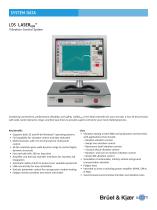
Vibration controller LDS Laser USB


Add to favorites
Compare this product
Description
LDS LASER USB Vibration Controller provides 4 channels, which can be expanded to 16 channels for simultaneous input. The controller combines convenience, performance, flexibility, and safety, making it suitable for any lab.
The LDS® LASERUSB™ vibration controller is designed to generate a shaker drive signal and perform data measurements. Typically used in R&D and production test applications, such as simulation of fatigue and vibration tests for automobiles, military vehicles, and ground transportation, it combines 24-bit precision with a wide dynamic control range and fast loop times, securing accurate control suited for the most challenging vibration tests.The controller is capable of working with a wide variety of vibration test systems and software-based vibration test profiles, as listed below.
• Random, sine, and shock tests
• Swept-sine testing
• Resonance search, track and dwell (RSTD)
• Random-on-random and sine-on-random tests
• Shock response spectrum (SRS) synthesis
• Time waveform replication (TWR)
• Fatigue tests
• Kurtosis parameter control
• Vibration tests according to MIL-STD, DIN, ISO, IEC, and other standards
Consisting of a controller module and Windows®-based application software, LASERUSB is flexible, reliable, and easy to install and operate. It can be configured with a comprehensive suite of vibration control and analysis applications, from random and sine excitations to SRS synthesis and time waveform replication.
The controller module handles real-time control-loop operations independently of the host PC, thus allowing users to concurrently analyze data and prepare test reports.
Catalogs
LDS Laser USB
16 Pages
*Prices are pre-tax. They exclude delivery charges and customs duties and do not include additional charges for installation or activation options. Prices are indicative only and may vary by country, with changes to the cost of raw materials and exchange rates.



